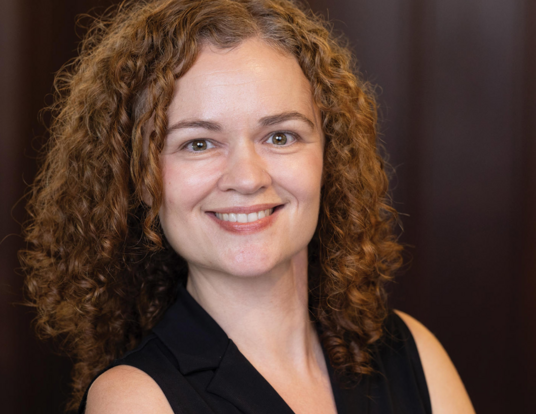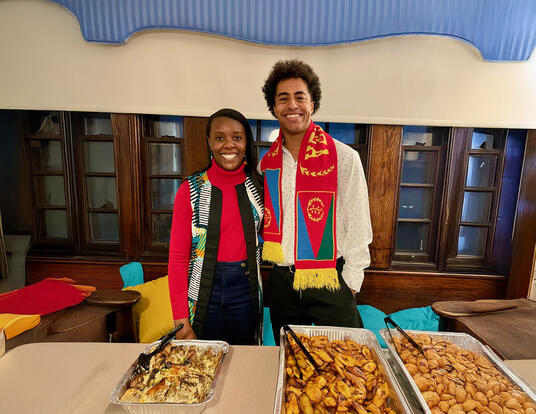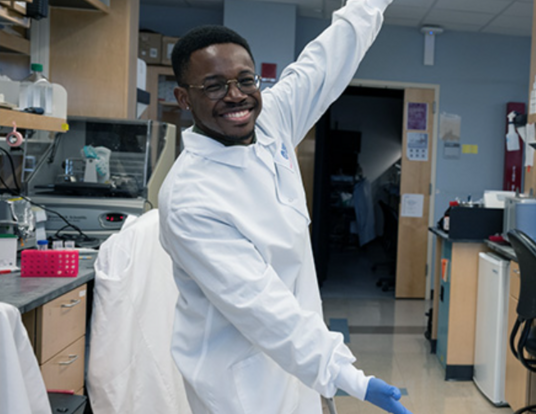Designed by Nature
Studying the glass sea sponge to construct a better building

“Not just anyone has these lying around,” Matheus Fernandes says as he puts a cardboard box down on the table. “These” are the skeletons of three glass sponges, commonly called Venus’ Flower Basket, each inside its own labeled plastic bag. The skeletons on display exhibit a simple tubular architecture that consists of fibrous building blocks organized into a square lattice structure with diagonal reinforcements. The resulting design is lightweight yet robust, and it has intrigued biologists and the general public for more than 150 years.
Glass sponges live in the deep sea, surviving on organic matter that they filter feed; the ones in Fernandes’ box came from the Western Pacific, a byproduct of other deep-sea explorations. Given the remoteness of their natural habitat, the glass sponges’ biology still presents many unknowns, such as why they evolved this repetitive skeletal structure and what role it might play in feeding. As a PhD candidate in applied mathematics, Fernandes asks more applied questions, specifically, what are the mechanical properties of the glass sponge skeletal system and how might it provide inspiration for the design of stronger bridges and buildings?
Optimizing the Square
“At the work site of the new Harvard John A. Paulson School of Engineering and Applied Sciences building in Allston, you can see that the underlying steel frame of the building consists of a square lattice design with diagonal bracings in alternating squares,” Fernandes says, showing a photo of the new building under construction. According to him, the square lattice is one of the most basic building blocks in engineering, but it needs some form of reinforcement to keep it stable. Fernandes asks us to imagine an Ikea shelf without any backing. “Without diagonals or an attached back, the structure has no shear resistance,” he says. “So, if you barely lean against a square lattice structure, it can catastrophically collapse.”
In order to construct buildings and bridges that don’t collapse, engineers use a variety of strategies to reinforce square lattices, such as the diagonals seen in the Allston construction. “Researchers are continually developing complex topology optimization algorithms to come up with the best possible designs to minimize material use,” Fernandes says. But, according to him, because it’s very hard to include a penalty for practicality, the algorithms suggest designs that are too complex and impossible to construct. “You get something that is theoretically very strong, but simply isn’t practical.”
“If we look closely at nature, we can find elegant solutions to challenging engineering problems,” Fernandes says, picking up a glass sponge. “This is the type of creativity that humans often miss when we instead focus our efforts on very high-level math and optimization algorithms.”
To diagonally reinforce the square lattice skeletal system, the glass sponge uses two sets of intersecting parallel strut-like elements. The resulting organization is a checkerboard-like pattern consisting of alternating open and closed cells. No modern structure has currently been built using the sponges’ design strategy, so Fernandes investigated how this design compared to similar diagonally reinforced square lattices. “We 3D-print and laser cut these models and see how they behave under a compressive load to determine their overall strength and failure modes,” he explains.
In these experiments, the sponge’s double diagonal square lattice performed better than other similar designs. “Square steel support lattices were first used in building construction in the late 1800s, and for the past century, there have been only minor changes to the basic organization of diagonal bracings using their design,” Fernandes says. “Now, we’ve found a model that performs above and beyond what we had previously used, without adding any additional weight.” According to Fernandes, this sponge-inspired design strategy can make lattice systems 20 to 30 percent stronger, if not more.
To Market
One of the reasons Fernandes chose to work on glass sponges and double diagonal square lattices was the promise of a technology that would impact construction. “I find it personally rewarding to have a final product that’s not only simple, but easily and economically implementable,” he explains.
It can take decades for a revolutionary technology to make its way into a product. The chemically strengthened Gorilla Glass from Corning waited almost 50 years to be deployed in the screens of iPhones, while the inductive charging technology now used for wirelessly charging smartphones has been around for decades. “If you let it sit, it’ll sit forever until someone finds it,” Fernandes says, explaining that he doesn't want to let this technology languish. He’s actively working with the Wyss Institute for Biologically Inspired Engineering at Harvard on a commercialization strategy for the patented technology, developing strategic partners and creating connections to get these double diagonals into use. “With Harvard and the Wyss, we have an extra push to get this technology out to functional applications in 10 years or less, instead of the normal 30 or 40.”
Recently, Fernandes was appointed a Harvard Horizons scholar, one of eight students selected. Together they will receive mentorship from faculty fellows as well as from the Derek Bok Center for Teaching and Learning, leading to the Harvard Horizons symposium, which this year takes place on April 10, 2019, at 4:30 p.m. in Sanders Theatre.
For Fernandes, Harvard Horizons is part of his ongoing mission to get the idea of double diagonal lattices out into the world. “The program is providing me with an opportunity for mentorship and training,” Fernandes said. It has also changed the way he structures his presentations, allowing him to more effectively present his research to a broader audience.
Fernandes isn’t planning on using his new communications skill set only at the symposium; he has a number of conferences coming up and plans to incorporate a few of the lessons learned into his talks. “At conferences, most people in the room are distracted, on their computers and phones and not paying attention to the speaker,” Fernandes says. “But there’s always at least one person in every session who captures people’s attention, where everybody closes their laptop and watches attentively,” he adds. “Those are the people at the end of the conference whom others crowd and ask questions, and that’s the type of effective and persuasive communication I aspire to do.”
Hear eight outstanding PhD candidates speak at Harvard Horizons on April 10 at Sanders Theater.
The event is free and open to the public.
Photo by Stu Rosen
Get the Latest Updates
Join Our Newsletter
Subscribe to Colloquy Podcast
Simplecast




